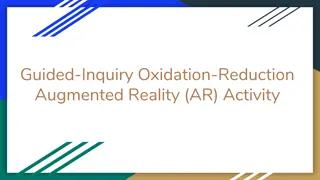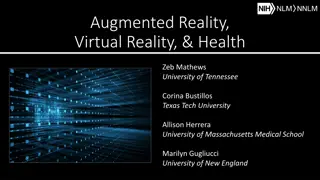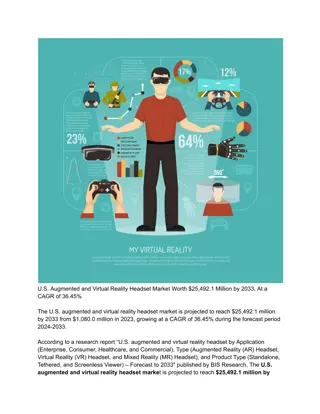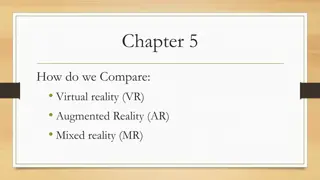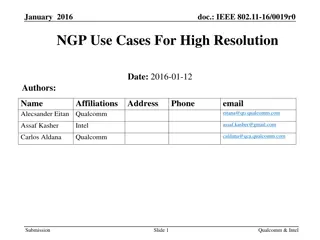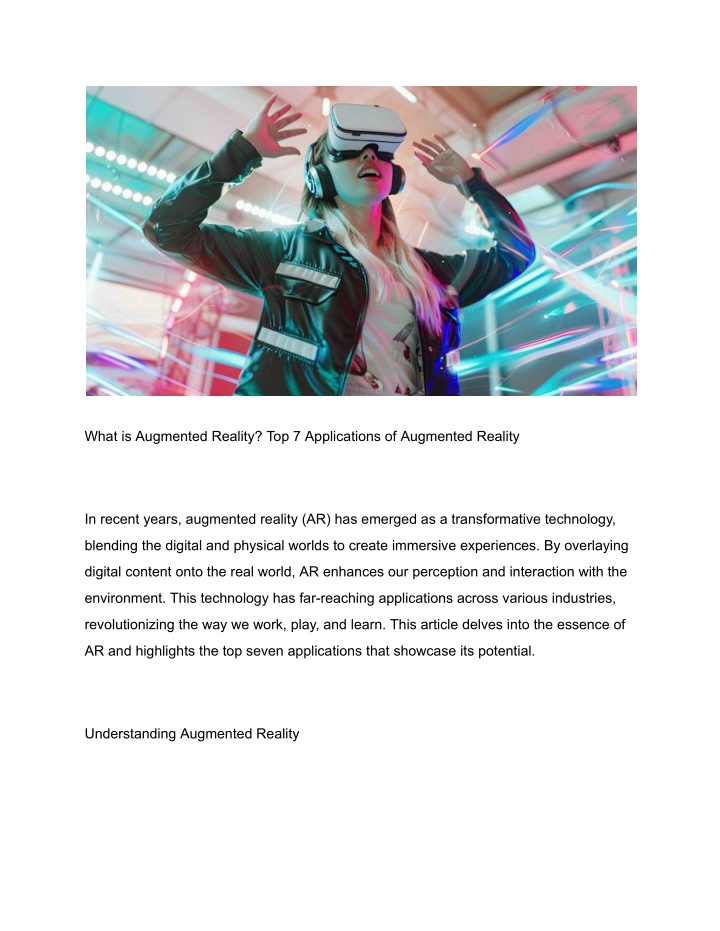
What is Augmented Reality? Top 7 Applications of Augmented Reality
In recent years, augmented reality (AR) has emerged as a transformative technology, blending the digital and physical worlds to create immersive experiences. By overlaying digital content onto the real world, AR enhances our perception and interactio
Download Presentation

Please find below an Image/Link to download the presentation.
The content on the website is provided AS IS for your information and personal use only. It may not be sold, licensed, or shared on other websites without obtaining consent from the author. If you encounter any issues during the download, it is possible that the publisher has removed the file from their server.
You are allowed to download the files provided on this website for personal or commercial use, subject to the condition that they are used lawfully. All files are the property of their respective owners.
The content on the website is provided AS IS for your information and personal use only. It may not be sold, licensed, or shared on other websites without obtaining consent from the author.
E N D
Presentation Transcript
What is Augmented Reality? Top 7 Applications of Augmented Reality In recent years, augmented reality (AR) has emerged as a transformative technology, blending the digital and physical worlds to create immersive experiences. By overlaying digital content onto the real world, AR enhances our perception and interaction with the environment. This technology has far-reaching applications across various industries, revolutionizing the way we work, play, and learn. This article delves into the essence of AR and highlights the top seven applications that showcase its potential. Understanding Augmented Reality
Augmented reality is a technology that superimposes computer-generated images, sounds, and other sensory inputs onto our real-world view. Unlike virtual reality (VR), which creates a completely immersive digital environment, AR enhances the real world with digital elements, allowing users to interact with both simultaneously. AR can be experienced through devices such as smartphones, tablets, AR glasses, and headsets. Top 7 Applications of Augmented Reality 1. Education and Training AR is transforming the education sector by making learning more interactive and engaging. Students can explore 3D models of historical landmarks, biological structures, and complex machinery, providing a deeper understanding of the subject matter. In professional training, AR can simulate real-world scenarios, enabling hands-on practice without the associated risks or costs. 2. Healthcare In healthcare, AR is enhancing diagnostic and surgical procedures. Surgeons can use AR to visualize internal organs and tissues during operations, improving precision and reducing the risk of complications. Additionally, AR applications can assist in medical training, allowing students to practice procedures in a controlled, virtual environment.
3. Retail and E-commerce AR is revolutionizing the retail industry by offering virtual try-ons and product visualizations. Customers can see how furniture will look in their home, try on clothes, or even test different makeup products, all from the comfort of their own space. This not only enhances the shopping experience but also reduces return rates and increases customer satisfaction. 4. Real Estate Real estate professionals are leveraging AR to provide virtual tours of properties. Potential buyers can explore homes and commercial spaces in detail, even before visiting in person. AR can also be used to stage properties virtually, showcasing different furniture arrangements and interior designs to attract buyers. 5. Entertainment and Gaming The entertainment industry has been one of the earliest adopters of AR. Popular games like Pok mon GO have demonstrated the potential of AR to create engaging and interactive experiences. AR is also being used in live events, theme parks, and museums to provide immersive storytelling and interactive exhibits.
6. Manufacturing and Maintenance In the manufacturing sector, AR is being used to improve efficiency and accuracy. Technicians can access real-time information and instructions through AR glasses, enabling them to perform complex tasks with greater precision. AR can also assist in equipment maintenance by overlaying diagnostic data and repair instructions onto the machinery. 7. Navigation and Tourism AR is enhancing navigation systems by providing real-time information and directions overlaid on the real world. Tourists can use AR applications to explore new cities, with information about landmarks, restaurants, and attractions displayed on their screens. This enriches the travel experience and helps users discover hidden gems. Conclusion Augmented reality is reshaping various industries by merging the digital and physical worlds in innovative ways. From education and healthcare to retail and entertainment, AR is enhancing our experiences and transforming how we interact with our environment. To explore more about the fascinating world of AR and its applications, visit What is Augmented Reality? Top 7 Applications of AR.




